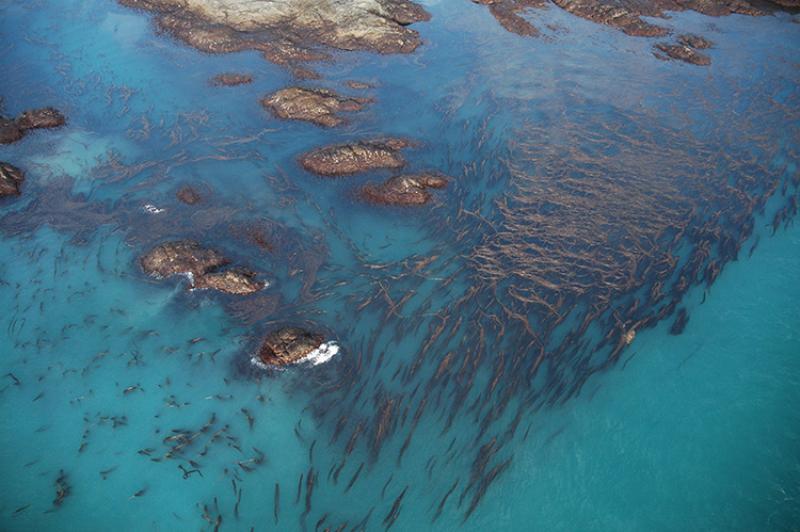
Canopy Kelp forests persist in Coastal Alaska despite century of climatic and ecosystem change
by NOAA Fisheries 6 Nov 2023 22:23 UTC

Aerial photograph of a kelp forest apparently aligned with predominant currents. The aquamarine color of the water probably indicates proximity to glacial outwash. Alaska, Icy Strait © Alaska ShoreZone Program NOAA/NMFS/AFSC; Mandy Lindeberg
Drawing upon diverse datasets, scientists look for patterns of change and stability in an important nearshore habitat in a data-scarce region.
Contrary to trends observed at lower latitudes, the kelp forests that ring the Gulf of Alaska have been remarkably stable and even increased in the past hundred years.
"Over the past century, the North Pacific Ocean has undergone oceanographic and ecological regime shifts which have the potential to strongly influence the structure and function of kelp ecosystems. However, the remoteness and complexity of coastal Alaska precludes regular monitoring efforts that would be necessary to detect such changes," said study lead Jordan Hollarsmith.
To begin to fill this critical knowledge gap, scientists from the Alaska Fisheries Science Center drew upon historical and modern surveys. They analyzed changes in spatial coverage and species composition of canopy kelp between 1913 and the early 2000s to 2010s in Southeast and Southcentral Alaska.
They also incorporated decadal surveys on sea otter range expansion to determine if the spatial extent of canopy kelp changed after sea otters were reintroduced to parts of Southeast Alaska.
"By combining these diverse data sources, we have provided the first spatially and temporally extensive analysis of Alaska canopy kelp ecosystems. We found evidence for increases in kelp extent after trophic and geologic disturbance, and overall stability of kelp ecosystems despite oceanographic changes," said Hollarsmith.
The results of this study were published in the Annals of Botany special issue "Macroalgae in a Changing World."
Examining Kelp Datasets
The historical datasets were maps of canopy kelp created by expeditions in the early 20th century to investigate domestic sources of potash salts. Potash salts are an important component of agricultural fertilizer. This is the first time that the 1915 Cameron dataset has been digitized and georeferenced.
The modern datasets were from ShoreZone surveys. These surveys mapped 94 percent (more than 120,000 kilometers) of the nearshore habitat in Alaska from 2001-2016, using imagery taken from low-flying aircraft.

Both datasets included information on the linear extent and density of the three species in the North Pacific that form floating canopies:
- Dragon kelp
- Bull kelp
- Giant kelp
Researchers also analyzed surveys of sea otter range extent in Southeast Alaska from 1968 to 2003 to assess the influence of trophic recovery on kelp ecosystems.
Changes in Canopy Kelp
The data suggest that canopy kelp along the shoreline increased between 1913 and the early 2000s. This is contrary to general trends of kelp decline observed along much of the Pacific basin.
Kelp in Southcentral Alaska showed extensive recovery after the 1912 eruption of the Novarupta volcano. Southeast Alaska showed persistence and spatial increase of kelp.
Scientists also observed evidence for the keystone role sea otters play in kelp ecosystems. Areas with a longer history of sea otter occupation also had more kelp in recent surveys than areas with no or only recent sea otter occupation.
Changes in Kelp Species Composition
While canopy kelp persisted in the surveyed areas, researchers found evidence that the species composition of the beds may have changed in the past century.
Canopy kelp species associated with warmer water increased in the modern survey compared to the historic survey. For example, there was an overall increase in the number of beds dominated by bull kelp, a temperate species whose northern range limit is Southcentral Alaska. They also saw a general decrease in beds with a dragon kelp canopy, a subpolar species whose southern range limit is Southeast Alaska.
In Southeast Alaska, this could be the consequence of increasing sea surface temperature and decreasing surface salinity from accelerated glacial melt. Both have been shown to negatively impact the early life stages of dragon kelp more than bull kelp or giant kelp. Changes in species composition could also be due to differences in the seasonal timing between the two surveys. Different kelp species reach maximum canopy extent at different times throughout the summer.
Importance of Long-term Monitoring Efforts
The results of the study suggest remarkable stability in the overall coverage of canopy kelp habitat in Southeast Alaska. They also show a dramatic expansion of canopy kelp habitat in Southcentral Alaska after the catastrophic Novarupta volcanic eruption.
This combination of stability and change highlights the dynamic nature of canopy kelp ecosystems. It also suggests the importance of surveys to be able to catalog that change.
However, the surveys do not include the last decade of particularly anomalous conditions. The record-breaking Pacific marine heatwave event of 2014-2016 profoundly altered subtidal kelp ecosystems from Baja California, Mexico, to Washington State.
To improve monitoring, Hollarsmith proposes identifying sentinel kelp beds for regular monitoring. This will enable her to more readily detect changes to these iconic and foundational canopy kelp species. These sentinel kelp beds could be monitored at regular intervals using remote sensing techniques and through collaboration and engagement with coastal communities.
Novel tools such as KelpWatch, which use Landsat satellite imagery to detect kelp, can be used to assess change in remote areas where physical access is challenging. However, Alaska's fringing kelp beds and overcast summers can make satellite monitoring challenging, so collaborating with coastal communities is essential to future efforts.
"Regardless of the approach used, it will be critical to monitor this expansive and important habitat at a higher temporal resolution than 100 years, especially as the environment continues to rapidly change," said Hollarsmith.